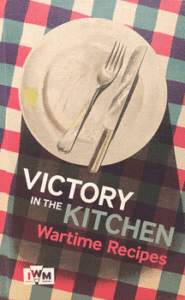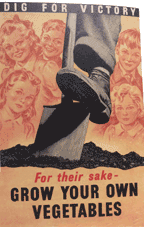New book takes a fascinating look at the recipes – and the inventiveness – of British kitchens in WWII.
 An interesting book crossed our desks this week, courtesy of London’s International War Museum. Victory in The Kitchen: Wartime Recipes is a highly readable tome providing an absorbing insight into WW2 Britain and the drastic demands which rationing and the war effort put on the home cook. The book is divided like a menu into Starters, Mains and Puddings and also has a section on baking, conversion tables and an enlightening introduction detailing the challenges facing Britain after the outbreak of war in 1939.
An interesting book crossed our desks this week, courtesy of London’s International War Museum. Victory in The Kitchen: Wartime Recipes is a highly readable tome providing an absorbing insight into WW2 Britain and the drastic demands which rationing and the war effort put on the home cook. The book is divided like a menu into Starters, Mains and Puddings and also has a section on baking, conversion tables and an enlightening introduction detailing the challenges facing Britain after the outbreak of war in 1939.
As an island nation Britain was heavily dependent on important raw materials and footstuffs. But as German U-boats began to decimate merchant shipping in 1940 the government realized that not only was it vitally important to make the mnost of the food that DID arrive, but also of the dire need for Britain to feed itself – and quickly. The resulting push towards cultivating land for food production – the ‘Dig for Victory’ campaign, saw almost every park, playing field, railway embankment, flower bed and other sliver of land converted into vegetable patches. Soon the Women’s Land Army swung into action to replace the male laborers who had gone off to fight.
The government was also acutely aware that Britons needed to feel a sense of shared sacrifice. Between the fall of France and Hitler’s invasion of the Soviet Union Britain stood very much alone. Defeatism and talk of accommodation with the Germans was in their air. The last thing Britain needed was a civil crisis over ‘fair shares’ and whether the rich had more than the poor. The government took quick action to resurrect the Ministry of Food, which had first begun in WWI. Rationing was introduced, its purpose to distribute food evenly across the population and prevent shortages becoming a critical problem. Weekly allowances and coupon books became part of the nation’s landscape. Britons were forced to come up with creative new ways to do without – and this book’s recipes reflect that – there are eggless cakes, the innovative use of honey as a sweetener, and ‘mock’ dishes imitating family favorites. For a population that loved its Sunday roast, non-rationed rabbit suddenly became a favorite. And when the Ministry wasn’t advocating new recipes it championed the health benefits of vegetables. So it wasn’t all bad…
 At first glance it’s notable how many WW2 recipes were vegetarian. Root vegetables in particular were staples, with copious suggestions in the book for Swedes (rutabagas), carrots, turnips, parsnips and potatoes. Swede soup, lentil and parsley soup, and mock oyster soup (basically water, fish trimming, leeks and artichokes) catch the eye, but the Scotch egg recipe, using reconstituted dried eggs, is hardly appetizing. Cabbage and fruit salad is barely more appealing, nor are the carrot croquettes, which feature added oatmeal for volume (!). As for the mains, dishes such as stuffed ox heart or Lancashire hot pot (featuring 6 oz of ‘scrag end’ mutton), egg and bacon pie and Mock Goose (basically cod with leeks and potatoes) don’t sound too bad, but some readers would perhaps rather go to bed hungry than attempt the recipe for lentil cutlets.
At first glance it’s notable how many WW2 recipes were vegetarian. Root vegetables in particular were staples, with copious suggestions in the book for Swedes (rutabagas), carrots, turnips, parsnips and potatoes. Swede soup, lentil and parsley soup, and mock oyster soup (basically water, fish trimming, leeks and artichokes) catch the eye, but the Scotch egg recipe, using reconstituted dried eggs, is hardly appetizing. Cabbage and fruit salad is barely more appealing, nor are the carrot croquettes, which feature added oatmeal for volume (!). As for the mains, dishes such as stuffed ox heart or Lancashire hot pot (featuring 6 oz of ‘scrag end’ mutton), egg and bacon pie and Mock Goose (basically cod with leeks and potatoes) don’t sound too bad, but some readers would perhaps rather go to bed hungry than attempt the recipe for lentil cutlets.
Onto dessert. Most of the offerings here are of the stodgy traditional variety, think jam sponge and baked custard made with reconstituted egg. But the wartime chocolate pudding sums up the nation’s plight. The recipe calls for flour, carrot, sugar, bicarbonate of soda, baking power, milk, margarine, vanilla essence and ONE heaped tablespoon of cocoa. In other words, not much chocolate to speak of.
Another bonus of this charming little book are the illustrations. Wartime propaganda and bromides about not wasting food are overlaid with upbeat illustrations of cheerful housewives, hardworking land girls and brave troops. Slogans such as “Help Win the War on the Kitchen Front: Above All Avoid Waste” set the mood perfectly. It all seems a very long time ago.
It’s doubtful that many (if any) of the recipes in this book will become staples in a California household of 2017. As the introduction says: “Some are curiosities, and in some cases may even evoke shudders. Some are surprisingly delicious”. But what they do is provide an insight into the inventiveness of the British nation in extremis and allow the reader to gain a sense of what culinary triumphs were borne out of sacrifice and hardship.
Victory in the Kitchen: Wartime Recipes. Published by the Imperial War Museum. Introduction by Laura Clouting. 2016. ISBN 978-1-904897-46-0
